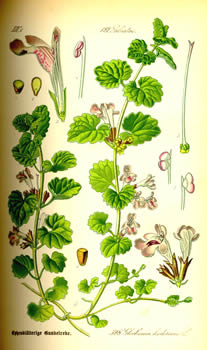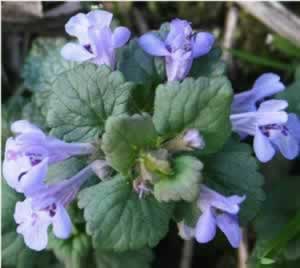Glechoma hederacea L
- Common Names
- Ground Ivy , Ale Hoof Gill-over-the-ground
- Botanical Name
- Glechoma hederacea L
- Family
- LAMIACEAE
Medicinal Uses & Benefits of Ground Ivy
![]() How to Use|
Side Effects |
Plant & Garden|
How to Use|
Side Effects |
Plant & Garden|
- Parts Used: flowering tops
How to Use:
Ground ivy is mostly ignored by modern materia medica in favor of the better known members of the mint family, but that does not mean this common little ground weed is not worth knowing. Search the term ground ivy on the internet and you will find a lot of information on how to kill it once it has invaded your lawn. I have pulled out uncounted handfuls of the stuff myself when it threatened to take over the lawn and smother the grass. But if you follow your search deeper into the old herbals you will find ground ivy was a highly regarded herb in the time of Galen and Dioscorides and the sheer number of common names in old English (alehoof, Lizzy or Robin runs up the hedge, hedge-maids, tunhoof, cat's foot, field balm and others) speaks to the place ground ivy held in country folklore in a simpler time. Writing in the 1970s, Alma Hutchens praised ground ivy as “A singular herb for all inward wounds, ulcerated lungs.. A decoction of ale hoof and a good wine taken over time will ease sciatica, hip gout or arthritic hands and knees.” She gives a salve recipe for easing all types of skin irritations mixing fresh calendula, ground ivy and honey which sounds as if it would be very effective indeed.(Handbook of Native American Herbs, pp1-2)
Primarily it is used as a bitter tonic, as a nutritive tea high in Vitamin C, and as an excellent remedy for a stubborn cough. 1
Preparation Methods & Dosage :Use 1/4 cup of the chopped whole herb for each cup of tea. Cover with boiling water and steep in a covered vessel. To use as a bitter tonic sip a half cup of chilled, unsweetened tea 1/2 hour before eating. The fresh leaf can be bruised and applied to ease cuts and insect bites.
Plant Description

Prof. Dr. Otto Wilhelm Thomé Flora von Deutschland, Österreich und der Schweiz 1885, Gera, Germany
- Plant Class:Perennial herb
- Etymology: Ground Ivy is so named for it's similar appearence to regular ivy
- FlowersPurplish blue, 3 to four in a cluster
- Parts used: Whole herb
- Leaves:Very similar in appearance to the related catnip, but much smaller and greener. Supline square stems, opposite, kidney shaped, green leaves. Downy, green and having rounded teeth on the margins. The plant rarely growns more than 6 inchen high, and layers over supporing vegetation.
- Flowering Season:April to winter freeze
- Distribution: Naturized over most of the civilized world, ground ivy was well known in Greece, Europe and old England and was introducted to North America in early times.
How to Grow
Can be grown in containers if you wish, in fact it often volunteers in the spring in any container left with soil over the winter.











